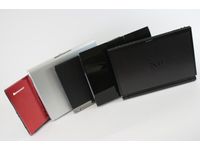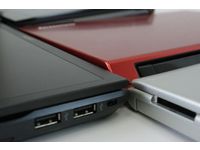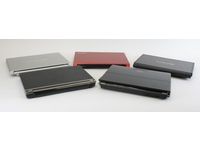Round Up: Five Powerful, Light Ultraportables
Introduction
Ed: This piece first ran on our sister site—Tom’s Guide—a week ago. We don’t do much mainstream notebook coverage on Tom’s Hardware—we focus on the mobile gaming hardware instead. However, because these are ultraportables, we thought they’d warrant a look here on the hardware side of things. If you read this story on Tom’s Guide last week, hopefully this note saves you a few minutes (check out our first Holiday Buyer’s Guide of the year instead). If you missed it, though, we hope you enjoy it now. Take it away, Rachel.
Consider The Ultraportable
PC manufacturers and industry analysts can’t stop talking about netbooks, those itty-bitty machines designed for nothing more than a bit of Web browsing. Netbooks may be selling like hotcakes—they are quite cheap, after all—but they’re not ideal for those who want to see connectivity, power and productivity from a thin and light notebook.
Take a netbook on a business trip, and it wouldn’t be able to hold all of your mission-critical applications and downtime entertainment. But what if you could have a featherweight machine that housed most of the innards you’d find in a 15-inch notebook? And how much would you pay for the privilege? Enter the ultraportable, a relatively new PC category taking the business and consumer markets by storm (though in the current economy, ultraportable manufacturers can’t take IT budgets for granted).
Ultraportables are expensive; the five we gathered in our offices range in price from $1,699 to $2,999. But before you get sticker shock, keep in mind that to qualify as an ultraportable—at least the Tom’s Guide’s definition of one—a computer must meet several criteria. It must weigh under 3 pounds, have a screen 12.1 inches in size or smaller, be about an inch thick, and contain several advanced add-ons or possess a luxury design. And odds are that an ultraportable will also feature an extremely low-powered and energy efficient Intel Core 2 Duo processor, a built-in optical drive, an LED backlit screen*, perhaps a solid state drive, and most likely an install of Windows Vista Business.
Most ultraportables have style, as well as the components to compete performance-wise with, say, a low-end 15-inch Dell. With ultraportables, there are sacrifices to be made for the sake of weight and size, though. An ultraportable is nobody’s sole PC—typically it is a third computer, but in some cases, a second.
Typically, ultraportables are marketed as business laptops. Executives and employees constantly on the road may request them from their IT departments, or entrepreneurs may want tiny machines to show off to potential clients. Because of their appeal to this niche, ultraportables are often equipped with security-focused features like fingerprint scanners, and are designed to look deluxe, sophisticated and somewhat conservative. They are often sold with the option for a docking station so road warriors can come home to roost comfortably. They may have the option for extended warranties and specialized damage repair options. And most of them do come with Windows Vista Business already on the machine, to cater to this crowd.
Ultraportables are also designed with consumers in mind. Some manufacturers are putting their little machines on sale in time for the holiday season, and sexy designs are catching the eyes of just about anyone who’d also consider the MacBook Air or any other popular 13.3” notebook.
Get Tom's Hardware's best news and in-depth reviews, straight to your inbox.
In this roundup, we’ve include the nearly weightless Toshiba R500, the leather-clad Asus U2E, the expressive Lenovo IdeaPad U110, the staid Fujitsu P8010, and the ultra high-end Sony Vaio TX (which Sony is currently phasing out in order to introduce the new Vaio TT that we will be reviewing soon). In addition to testing the battery life and benchmarking performance of these machines, I also tried to travel and live with these machines; in fact, I wrote each computer’s review on that machine.
We’ve considered three other factors when scoring the machines, besides battery life and performance: style, usability and price. Each computer received a score out of five points in each of the five categories; you’ll find the category score at the end of each category section.
In many ways, these five machines represent the early days of the ultraportable category. As manufacturers work out design kinks and components become ever smaller and stronger, we’ll soon—by necessity—determine entirely new definitions for the categories and methods for evaluating them.
Testing Battery Life and Performance
We tested battery life using the open source benchmark BatteryEater Pro v2.70. To test performance, we used Microsoft Windows Vista’s Windows Experience Index and FutureMark’s PCMark Vantage v1.00, with the November 2007 Hotfix. You can see the details of these tests on the Testing pages toward the end of this article. The Testing pages also present our methodology for the tests and for calculating summary scores (ranging from 1 to 5) for battery life and performance for each notebook. The summary scores are included in the discussion of each notebook immediately following.
To better understand why our tests turned out as they did, be sure to check out the Ultraportable Specifications page, which provides a comprehensive list of components in each of the five notebooks we tested.
*In the pages below, you will see pictures of ultraportable displays. Bear in mind that these photos are only relative representations of the screen’s true picture quality; we have not tested these displays for luminance or contrast levels.
-
these are all at the high-end of the price spectrum, have you considered the asus eee pc or acer aspire one? i have one of these, and while it's not exactly a gaming powerhouse it does all you need in a small laptop... mind you the linux distros these things come with can be a real painReply
-
JJeng1 A possible reason for the fingerprint reader placement. Look into the options of the fingerprint software, as sometimes the reader doubles as a scroll wheel.Reply -
Regulas Rubbish, get the the new Macbook, 13" screen plenty of power no viruses and no bloated Vista for the low end of cash stated in this review.Reply -
bjornlo ReplyRubbish, get the the new Macbook, 13" screen plenty of power no viruses and no bloated Vista for the low end of cash stated in this review.
Typical ignorant fanboi BS.
Get your facts straight. Nothing wrong with a Mac other than total cost of ownership and slightly reduced software choices... although the default browser is very unsecure (but fixable, DL any other). But, there is nothing special about them except their style and slightly better ease of use for the "technologically challenged". -
Placebo First of, Macs are rubbish. Buying one is alright for the creative crowd, whose fav. software is exclusive for OSX. Other than that, the company would have already closed up, if not saved by the mighty (LOL) Ipod-brand.Reply
Regarding the otherwise brilliant review, how come the Dell M1330 isn't mentioned, or even tested, its not even on the site?!?!
Best selling product in the category for almost two years. Anyone buying should look into it. Had one for around a year, can honestly say its the best electronic device i ever owned.
Its cheap, lightwight and with supurb spec!
www.notebookreview.com for notebooks :-)Sry... they jus do a better job.
-
boostercorp i guess i never understood why you'd need such a small underpowered laptop and also never knew who would buy such a thing.Reply
But if you're on the road alot like me it would be more handy then dragging around a 8 pound 17" laptop like i 'm currently doing.
i only hoped they'd be a little less expensive cause i bought my 17" for € 899 and got a shedload of stuff i didn't need like that fingerprint scanner ,bluetooth ,ir , ... -
Can we post a review of ultraportables with eSATA and Express Card ? I think the ASUS U6V (not sure) has one, the Dell E4200 and E4300 have eSATA but no Express Card. The Lenovo X200 and X300 series have some great features. I really hope manufacturers start making machines with eSATA and Express Card and not one or the other. Oh and How about the Toshiba dynabook R6 ?Reply
-
enforcer22 "Rubbish, get the the new Macbook, 13" screen plenty of power no viruses and no bloated Vista for the low end of cash stated in this review."Reply
O your right and look i cant do anything i want to do with it either.. I also cant get it to look like a computer instead of a over priced pos paperweight. Linux is as usless to me as that over priced thing keeping my desk up to.




